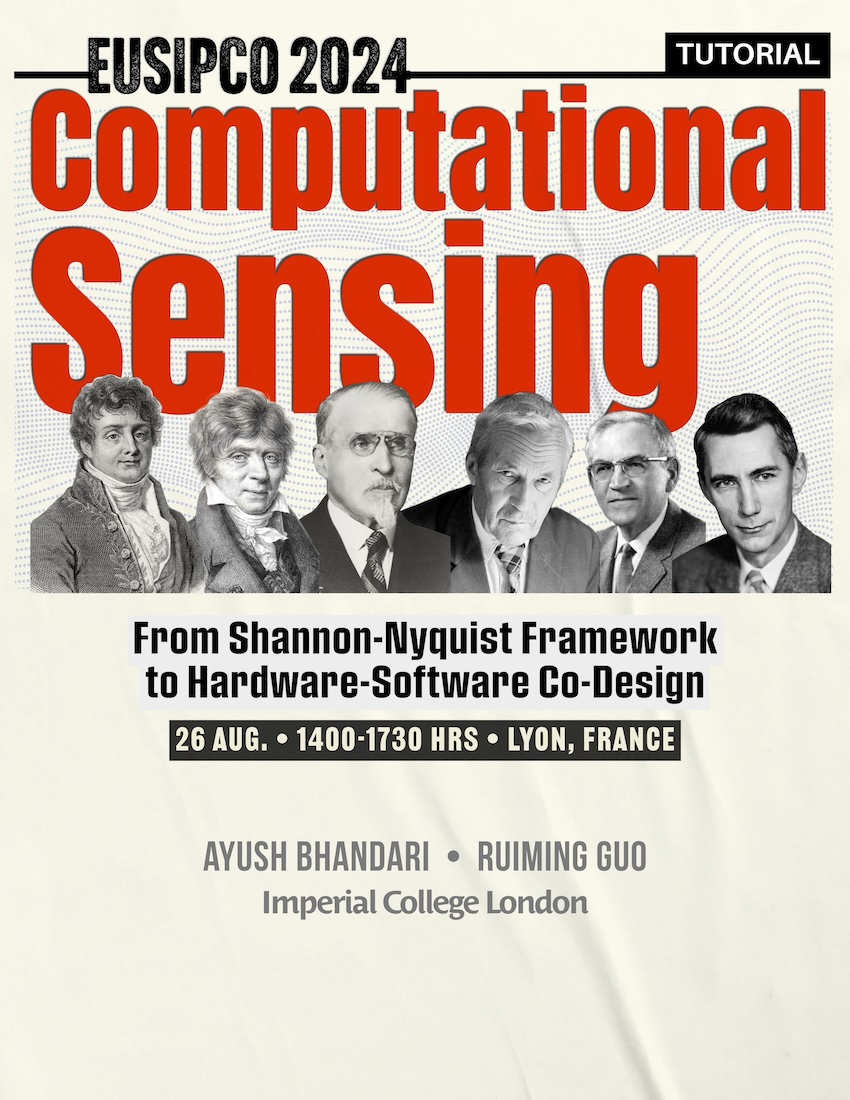EUSIPCO 2024 Tutorial
Computational Sensing: From Shannon Sampling to Hardware-Software Co-Design
Ayush Bhandari & Ruiming Guo
26 August • 1400-1730 Hrs • Lyon, France
 Abstract.
Digital data capture is the backbone of all modern day systems and “Digital Revolution” has been aptly termed as the Third Industrial Revolution. Underpinning the digital representation is the Shannon-Nyquist sampling theorem followed by more recent developments such as compressive sensing approaches. Almost all such approaches follow pointwise sampling strategies that have revolutionized how we capture signals and process them using sophisticated mathematical signal processing algorithms. These pointwise sampling strategies have transformed signal capture and processing through advanced mathematical algorithms, also laying the groundwork for the next wave of machine learning (ML) and artificial intelligence (AI) applications.
Abstract.
Digital data capture is the backbone of all modern day systems and “Digital Revolution” has been aptly termed as the Third Industrial Revolution. Underpinning the digital representation is the Shannon-Nyquist sampling theorem followed by more recent developments such as compressive sensing approaches. Almost all such approaches follow pointwise sampling strategies that have revolutionized how we capture signals and process them using sophisticated mathematical signal processing algorithms. These pointwise sampling strategies have transformed signal capture and processing through advanced mathematical algorithms, also laying the groundwork for the next wave of machine learning (ML) and artificial intelligence (AI) applications.
Yet, as the hardware is being pushed to its limits and computational resources become more accessible and efficient, it remains questionable if pointwise sampling is the best one can do. Across various scientific and engineering domains, researchers have explored alternative signal encoding methods, yielding unprecedented benefits. For instance, event-based or neuromorphic sampling in computational imaging and computer vision, one-bit ADCs in digital communications and massive MIMO systems, and the Unlimited Sensing Framework (USF) in signal processing have all demonstrated significant advantages of unconventional encoding over the traditional Shannon-Nyquist method.
Despite the proliferation of these novel encoding techniques—neuromorphic, one-bit, and modulo encoding—a comprehensive resource is missing that,
Provides a thorough introduction to these breakthroughs.
Unifies these concepts within the framework of sampling theory and SP in general, and
Fosters an end-to-end perspective by bridging theoretical concepts with their practical applications.
Our tutorial aims to fill this gap for the signal processing (SP) community, offering an insightful introduction into the emerging field of Computational Sensing that lies at the convergence of theory, algorithms, hardware, and experiments. Starting from foundational principles, we aim to guide both beginners and experts through the theoretical, algorithmic, hardware, and experimental aspects of Computational Sensing. Leveraging our decade-long experience with computational sensing and imaging including the development of the USF, the tutorial will feature case studies complete with Matlab/Python code and experimental data from recent research, enabling participants to gain practical insights and stay abreast of cutting-edge developments.
In spirit of reproducible research and rich learning experience, we will provide Matlab code and Hardware Data.